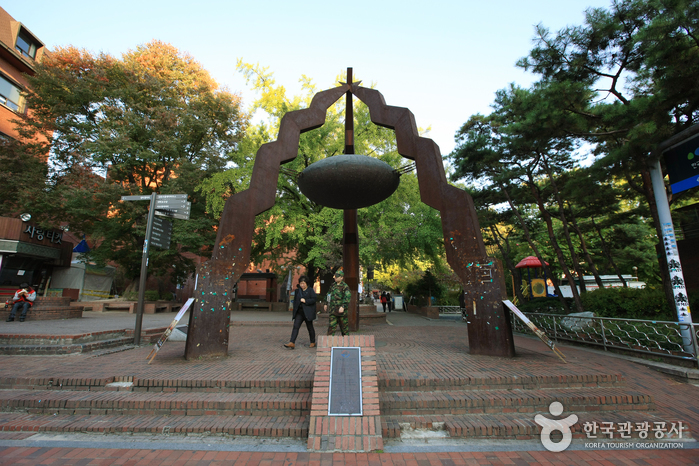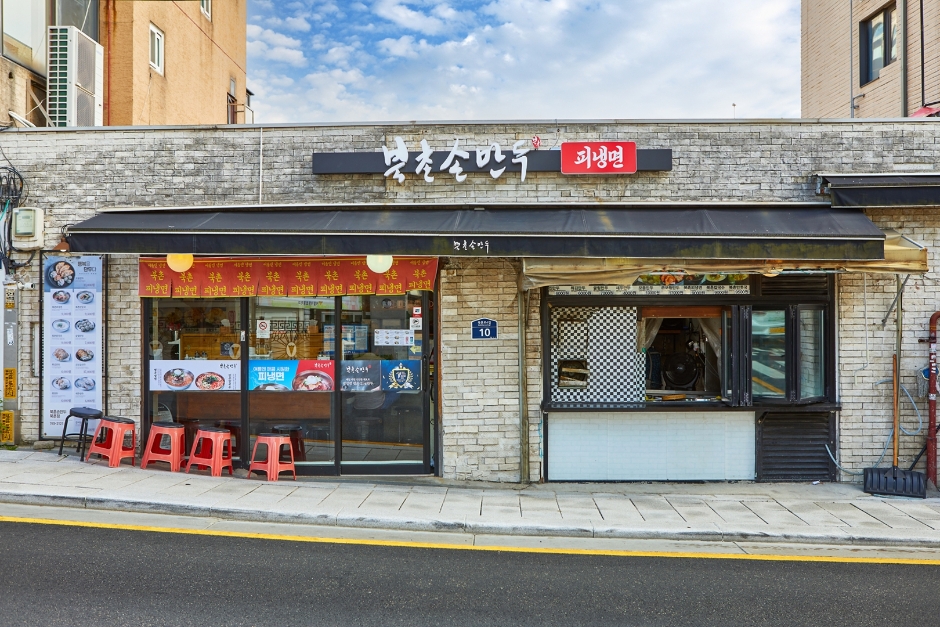Marronnier Park (마로니에공원)
1.4Km 2021-07-14
104, Daehak-ro, Jongno-gu, Seoul
+82-2-2148-4158
Marronnier Park was given its name due to the marronnier trees, or horse chestnut trees, growing within the area. The location where Seoul National University's College of Liberal Arts & Science and School of Law once stood, it is now a park dedicated to culture and arts open to the public. In addition to a variety of outdoor performances that take place throughout the area, exhibitions and cultural centers create a romantic atmosphere unique to the park.
Bukchon Son Mandu Bukchon Branch (북촌손만두 북촌점)
1.4Km 2024-12-10
This third-generation family-owned handmade mandu restaurant has been in business since 1953. Its handmade mandu bears the tradition of nearly 70 years. This restaurant distinguishes itself above others with its unique expertise in the art of mandu-making and fresh ingredients, capturing deep flavors with care in each mandu. A full spread of mandu is available here, from steamed mandu to thin-skin mandu, deep-fried mandu, shrimp mandu, and galbi mandu, which can be ordered in individual pieces or as an assorted package. Mandu and noodles go perfectly together, and here, visitors can enjoy mandu with cold buckwheat noodles or noodle soup. The most recommended menu is the noodle soup, which serves thick, plump noodles in warm broth. But that does not mean that the cold buckwheat noodles are lacking: cold buckwheat noodles are served in a cool, red kimchi broth.
Mijin (미진)
1.4Km 2024-03-06
19 Jong-ro, Jongno-gu, Seoul
+82-2-732-1954
Mijin is a Korean-style cold buckwheat noodle restaurant located near Gwanghwamun, specializing in Korean-style naeng memilguksu (cold buckwheat noodles). They offer a broth that is richer in flavor compared to Japanese soba bonito soy sauce, along with chewier buckwheat noodles. The restaurant produces the broth and noodles in-house and serves them directly to customers. The cold broth and buckwheat noodles condiments can be adjusted according to preference. Another popular menu is the memil jeonbyeong (buckwheat crepe) filled with bean sprouts, bean curd, aged kimchi, and ground pork.
Onnuri Pharmacy - Jongno Branch [Tax Refund Shop] (온누리약국 종로)
1.4Km 2024-04-19
1F, 293, Jong-ro, Jongno-gu, Seoul
-
Kaist Optical Shop [Tax Refund Shop] (카이스트안경)
1.4Km 2024-04-22
49, Myeongdong 2-gil, Jung-gu, Seoul
-
Gugus - Myeong-dong Branch [Tax Refund Shop] (구구스 롯데 명동점)
1.4Km 2024-04-23
11, Namdaemun-ro 7-gil, Jung-gu, Seoul
-
Yetmat Seoul Bulgogi (옛맛서울불고기)
1.4Km 2024-03-20
57, Myeongdong, 2-gil, Jung-gu, Seoul
+82-2-779-3000
Located in Myeongdong, Yetmat Seoul Bulgogi is a Korean restaurant that specializes in Seoul-style bulgogi. It is a thinly sliced, seasoned beef sirloin cooked in a broth with onions, green onions, and mushrooms. The characteristic of this menu is that the bulgogi is mildly flavored and dipped in soybean paste to suit your taste.
57 Myeongdong Hostel [Korea Quality] / 57명동호스텔 [한국관광 품질인증]
1.4Km 2024-07-30
57 , Myeongdong 2-gil, Jung-gu, Seoul
+82-2-778-8835, +82-10-3262-3503
Located in Myeong-dong, Jung-gu, Seoul, 57 Myeongdong Hostel is easy to remember because its name is the same as its address! Just a 5-minute walk from an airport bus-stop, and a 3-minute walk from Myeongdong metro station, the hostel offers single rooms with ensuite bathrooms, and is popular with single travelers or those on business trips. Breakfast, coffee and tea are provided free, and a mini washing machine can be used without charge. The hostel is close to the Myeongdong shopping district, and is also convenient for nearby tourist attractions. Tourist information and reservation services are provided at the front desk.
Gwanghuimun Gate (광희문)
1.4Km 2021-02-24
344, Toegye-ro, Jung-gu, Seoul
+82-2-3700-3900
Gwanghuimun Gate is said to have been originally constructed in 1396, the 5th year of King Taejo, at the southeast of the capital city. It was often referred to as Sugumun Gate (water channel gate) and was actually used as a Sigumun, literally meaning “corpse gate,” as funeral processions passed through this gate when exiting to the east.
During the Imjin War (1592-1598), the fortress gate was destroyed to such a degree that it made finding the original location close to impossible. Nevertheless, reconstruction efforts were started in 1711 (37th year of King Sukjong) and the gate was restored together with the gate's watchtower. Gwanghuimun Gate remained intact even when the fortress walls were demolished to build tram tracks during the Japanese occupation, but it was later damaged during the Korean War and left neglected. In 1975, restoration work was carried out to relocate Gwanghuimun Gate to a site 15 meters south of its original location since it stood in the middle of the road.
Olens - Myeong-dong Embassy Branch [Tax Refund Shop] (오렌즈 명동대사관점)
1.4Km 2024-04-22
50, Myeongdong 2-gil, Jung-gu, Seoul
-



![Onnuri Pharmacy - Jongno Branch [Tax Refund Shop] (온누리약국 종로)](http://tong.visitkorea.or.kr/cms/resource/89/2878189_image2_1.jpg)
![Kaist Optical Shop [Tax Refund Shop] (카이스트안경)](http://tong.visitkorea.or.kr/cms/resource/47/2878647_image2_1.jpg)
![Gugus - Myeong-dong Branch [Tax Refund Shop] (구구스 롯데 명동점)](http://tong.visitkorea.or.kr/cms/resource/86/2878586_image2_1.jpg)

![57 Myeongdong Hostel [Korea Quality] / 57명동호스텔 [한국관광 품질인증]](http://tong.visitkorea.or.kr/cms/resource/34/2610934_image2_1.jpg)

![Olens - Myeong-dong Embassy Branch [Tax Refund Shop] (오렌즈 명동대사관점)](http://tong.visitkorea.or.kr/cms/resource/05/2878605_image2_1.jpg)
 English
English
 한국어
한국어 日本語
日本語 中文(简体)
中文(简体) Deutsch
Deutsch Français
Français Español
Español Русский
Русский